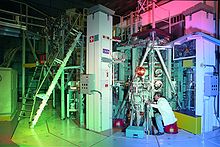Tokamak à configuration variable
| Tokamak à configuration variable | |
|---|---|
MW | |
| Discharge duration | 2 s |
| Plasma current | 1.2 MA |
| History | |
| Year(s) of operation | 1992–present |
| Preceded by | TCA (now TCABR) |


The tokamak à configuration variable (TCV, literally "variable configuration tokamak") is an experimental tokamak located at the École Polytechnique Fédérale de Lausanne (EPFL) Swiss Plasma Center (SPC) in Lausanne, Switzerland. As the largest experimental facility of the Swiss Plasma Center,[1] the TCV tokamak explores the physics of magnetic confinement fusion. It distinguishes itself from other tokamaks with its specialized plasma shaping capability, which can produce diverse plasma shapes without requiring hardware modifications.
The research carried out on TCV contributes to the physics understanding for
The TCV tokamak produced its first plasma in November 1992 with full tokamak operation starting in June 1993.[3]
Characteristics
Plasma shaping
TCV features a highly elongated, rectangular vacuum vessel and 16 independently powered coils which facilitate development of new plasma configurations. A notable example is the discovery of significantly improved confinement with the negative triangularity shape in the late 1990s.[4] Novel divertor configurations such as the snowflake divertor were also realised and explored on TCV.
ECRH-ECCD system
Auxiliary heating is provided by the electron cyclotron resonance heating (ECRH) system. EC power in X-mode supplied by the X2 (second harmonic) and X3 (third harmonic) gyrotrons can be launched from the side or the top. The system can also support non-inductive plasma current via electron cyclotron current drive (ECCD). TCV is the first machine in world which has reported plasma with full current in ECCD in 2000.[5]
Neutral beam injection system
The neutral beam injection (NBI) system has been operated on TCV from 2015 for direct ion auxiliary heating which facilitates access to plasma regimes with high plasma pressure, a wider range of temperature ratios, and significant fast ion population.[6] TCV currently has two heating neutral beams and a diagnostic neutral beam. The first heating neutral beam injector can provided up to 1.3 MW of heating power.
Removable neutral baffles
TCV features an "open" divertor historically with limited separation between the divertor region and the main plasma. In 2019, TCV began to operate with removable neutral baffles in order to maximise the divertor neutral compression by limiting the transit of recycling neutrals from the wall to the confined plasma.[7] Baffles of different lengths are available, allowing for experimental study of variable divertor closure.
Main studies
- Confinement studies
- confinement as a function of the shape of the plasma (triangular, square or elongated)
- Improvement of the confinement of the core
- Studies on vertically elongated plasmas
- Studies with ECRH and ECCD (electron cyclotron resonance heating and electron cyclotron current drive)[8]
History
- 1976: First proposal for an elongated tokamak by the "New Swiss Association"
- 1985: Second proposal, with a more elongated tokamak
- 1986: Acceptance of the TCV proposal (Tokamak à Configuration Variable)
- 1992: First plasma discharge
- 1997: World record of plasma elongation (see plasma shaping)
- by August 2015 it has had a 19-month shutdown/upgrade to install its first neutral beam injector.[9]
References
- ^ "Swiss Plasma Center (SPC) | ETH-Board". www.ethrat.ch. Archived from the original on 2020-12-03. Retrieved 2020-12-08.
- ^ "Medium-Sized Tokamaks". EUROfusion. Retrieved 2023-08-19.
- S2CID 250759524.
- S2CID 250775203.
- PMID 11019080.
- .
- S2CID 234294126.
- ^ TCV Auxiliary Heating.
- ^ Keeping fusion research on the boil: Three tokamaks and one stellarator. August 2015
External links
- TCV official site
- TCV Technical data as of Oct 2012
